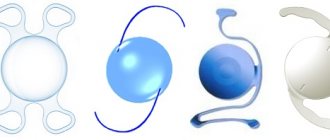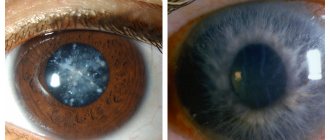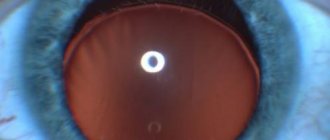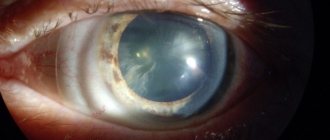Features of laser surgery for astigmatism
Astigmatism implies the absence of a focal point. It occurs due to the irregular shape of the cornea, less often the disease is caused by a change in the shape of the lens.
The peculiarity of laser vision correction is the formation of a spherical surface. Achieving a normal shape of the cornea is achieved by removing its superficial and deeper layers.
Vision correction for astigmatism and myopia is carried out by burning a precisely calculated amount of tissue to give the required shape.
Cataracts and astigmatism
There are often cases when cataracts, partial or complete clouding of the lens, are combined with astigmatism. Astigmatism in Latin means absence of a (focal) point.
This disease occurs due to the irregular (non-spherical) shape of the cornea (corneal astigmatism), and less commonly, the lens (lenticular astigmatism). The effect of corneal astigmatism on vision is greater than that of the lens, since the cornea has a greater refractive power.
Important
Cataracts combined with astigmatism create certain difficulties for the surgeon, since if you simply remove the cataract, then, unfortunately, the person will still not be able to see well without special cylindrical glasses.
In the presence of cataracts with corneal astigmatism, experts suggest solving the problem with surgery - ultrasound phacoemulsification with implantation of a toric IOL.
These intraocular lenses are designed specifically to solve the problem of cataracts combined with corneal astigmatism.
A toric intraocular lens not only replaces the optical power of the removed cloudy lens, but also corrects the original corneal astigmatism.
In the presence of cataracts with lenticular astigmatism, a modern, effective, painless and non-traumatic operation is performed - ultrasonic phacoemulsification with implantation of an artificial intraocular lens.
This method not only eliminates the very reason - the nonsphericity of the lens, but also allows you to achieve good vision results.
For the most effective treatment of cataracts with astigmatism and to achieve maximum visual acuity after surgery - phacoemulsification, excimer laser correction is also performed.
Laser correction is performed in a “one-day” mode, that is, without hospitalization. The depth of exposure is strictly limited - no more than 130–180 microns, so we can confidently speak about the accuracy and safety of this treatment method.
Indications for laser vision correction for astigmatism
Glasses and contact lenses are suitable treatments for astigmatism, but for permanent and complete recovery, laser eye surgery is the primary option. Modern methods of laser surgery make it possible to treat even the most severe astigmatists with great success.
Whether surgery is appropriate will depend on your overall health and other factors.
Laser correction is indicated in the following cases:
- astigmatism is combined with myopia;
- presence of the disease at the age of over 18 years;
- refractive error greater than 3 diopters;
- the presence of progressive pathologies of the inflammatory nature of oncology.
Astigmatism: surgical correction methods
With this disease, the integrity of the lens or corneal film is disrupted, which leads to blurred vision, in which the picture is partially distorted. If this disease is not treated, the patient will soon develop complications such as a significant decrease in visual acuity and the development of strabismus.
When diagnosing the disease in children, they are prescribed glasses, in adolescents - contact lenses or glasses, and for patients over 18 years of age, the doctor may prescribe surgical removal of the pathology. The list of the latter consists of the following methods:
- laser correction for the treatment of corneal astigmatism;
- Lensectomy - replacement of the native lens with an implant. Prescribed in severe cases of disease development;
- keratotomy for the treatment of myopic or mixed type of disease;
- cauterization for simultaneously progressive astigmatism and farsightedness;
- laser coagulation.
Now you know the name of the operation to replace the natural lens of the eye with an artificial one. Lensectomy, like other types of operations, has its pros and cons, so before prescribing the procedure, the doctor conducts a detailed examination of the patient and determines the level of visual impairment.
Contraindications
Laser treatment of astigmatism is contraindicated in patients over 45 years of age, with progressive forms of refractive error (myopia or hypermetropia), glaucoma and lens opacification.
Laser correction is not performed for acute inflammatory processes and infectious diseases. It is also contraindicated during pregnancy, the postpartum period, during breastfeeding (since it will require taking antibiotics and other drugs that pass into breast milk) and for endocrine disorders.
Types of laser vision correction
Correction is possible using all currently existing methods:
- ReLex SMILE - this vision correction is indicated for astigmatism and myopia or a combination of both refractive errors with a small incision on the surface of the cornea.
- FLEX is 100% femtosecond technology. Similar to SMILE, an individual lens is cut into the cornea, but a flap cap is cut around its circumference to remove it.
- Femto LASIK—use of a femtosecond laser.
- LASIK—Laser keratomileusis is used to treat nearsightedness, farsightedness, and astigmatism. Since its invention in the early 90s, LASIK has been the most popular surgical treatment for correcting refractive errors. Treats vision defects by reshaping the cornea to correct the way light is focused at the back of the eye.
- PRK involves creating a thin circular flap and loosening the top layer of corneal cells using a special solution. This surgery may be an option for patients who are looking for a cost-effective refractive laser surgery option.
- Opti LASEK is a more advanced OptiPRK technique. It consists of removing the epithelium in a single layer, returning to the surface at the end and installing a contact lens.
Surgery
Eye surgery for astigmatism is necessary when the use of corrective optics does not bring the desired result and a person’s quality of life is significantly reduced.
There are several types of operations to eliminate astigmatism:
- Keratomy. During the operation, small incisions are made on the corneal layer with a scalpel. The procedure is performed under local anesthesia and lasts no more than 5 minutes. Using notches, the curvature of the refractive surface is corrected. Today, such an operation is performed infrequently due to the high risk of complications.
- PRK method (photorefractive keratectomy). Before the procedure, an anesthetic and a special solution with alcohols are dripped into the eye to soften the epithelial cells of the cornea. After this, the surface layer is scraped off with a medical spatula. An excimer laser removes part of the corneal tissue to impart the desired curvature and correct refraction. This is done by evaporation, as a result of which part of the cornea is removed to the required thickness. After evaporation, a thin flap of tissue is applied to the eye to level the cornea, which heals on its own.
- Lasik. Modern technology consists in removing not the superficial, but the internal layers of the cornea. The surgeon makes an incision in the tissue of the outer layer of the cornea, cuts out a flap and folds it back. Before this, marks are applied to the eye. Then, using a laser beam, the deformed particles of the inner layer are evaporated, and the flap is returned to its place. It is not sutured, since it itself sticks to the underlying layers due to negative pressure.
- Thermocoagulation. An operation to correct astigmatism, during which the thickness of the cornea is optimized by applying microburns with a special hot needle.
- Keratoplasty. A cornea transplant from a deceased donor is performed. As engraftment progresses, the donor cells are replaced by their own. This operation has many complications, so it is rarely performed.
- Keratoprosthetics using bioinert plastic material. Treatment is carried out if there is no hope for a donor cornea. The plate is fixed on special metal supports. After 2 months, a second operation is required to remove them. If there is no lens, then an artificial cornea can perform its functions.
- Lens prosthetics. Intraocular lenses (IOLs) are used. They are torus shaped and the back surface is cylindrical. This allows you to correct distortions characteristic of astigmatism. During surgery, the doctor places marks on the cornea to ensure the correct placement of the lens. The sclera is cut, a 5-6 mm channel is made in the cornea, the contents of the lens are crushed through it and the contents of the lens are sucked out. A tube with a rolled up artificial lens is inserted into the hole. It unfolds in the lens chamber, and the doctor guides it with light stroking and pressure. Then he rinses and applies a bandage.
- Phakic lenses . The operation is prescribed for people with a high degree of astigmatism and a thinned corneal layer. Its essence boils down to installing an artificial lens into the posterior or anterior chamber of the eye without removing the lens. Before surgery, an anesthetic is injected into the eye. After this, a micro-incision is made and the structure is installed. The recovery period lasts several days, and the risk of complications is 1%.
Read in a separate article: Surgery for glaucoma: surgical anti-glaucomatous treatment
Laser correction for astigmatism
The use of laser correction for refractive error depends on the type of procedure prescribed.
Some choose PRK despite the longer recovery period and discomfort after surgery. The outer top layer of cells is removed to expose the second layer to the laser. A protective bandage is put on the eye until the epithelium is restored.
The smile is made using a short impulse. The device is programmed to pass harmlessly through the top layers of the cornea, focusing on a specific sublayer to create a lenticule. The outer layer is not removed; only a small cut is made on the surface.
On average, the procedure takes 23 seconds for one organ of vision. The surgeon removes the lens formed by the laser inside the cornea. The corneal nerves that stimulate the tear glands are less affected and can therefore still help keep the eye moist.
With LASIK, the surgeon creates a piece of tissue by making a flap at the front of the eye to expose the inner layers of tissue to the laser. They use either a mechanical instrument called a microkeratome or a femtosecond laser. The excimer laser shapes the cornea by removing tissue that has been exposed to it. The procedure is completed by returning the flap to its original position.
After operation
Vision recovery occurs quickly. Upon arrival home, the patient will see better. Visual perception is completely normalized over the next 24 hours.
After operation:
- Do not rub the operated eye;
- rest more and not overexert yourself;
- wear sunglasses to prevent sun exposure and harmful UV rays;
- use eye drops for several days after surgery to prevent infection and relieve dryness;
- Avoid contact sports for 2 weeks.
Doctors recommend wearing the patch for 1 week while you sleep to avoid accidentally scratching your eye while it heals.
Smile is a minimally invasive procedure, which means there is usually minimal discomfort during the healing period. In most cases, vision stabilizes within a week after surgery.
The eye may sometimes feel uncomfortable. It usually takes 4-5 days to grow a new layer of cells. After this, the doctor will remove the bandage.
Possibility of complications
During the first time after surgery in the dark, contrast sensitivity is significantly reduced; patients have difficulty distinguishing the boundaries of colors and the boundaries of objects. Therefore, driving at night and at dusk is strictly undesirable.
Patients also noticed the appearance of stars and circles before their eyes. Cases of excessive dry eyes are common. Inflammatory processes such as edema, conjunctivitis, epithelial ingrowth, inflammation, hemorrhage may also appear as postoperative complications.
The likelihood of their occurrence does not depend on the qualifications of the surgeon or on the apparatus with which the operation was performed. The reason for them is the individual characteristics of the patient’s body.
Such complications may require long-term and quite expensive treatment, which, however, is not guaranteed to give a 100% result (full recovery). There is also the possibility of “undercorrection”.
This is the so-called residual myopia, which is corrected by repeated laser correction two months after the first operation. This is another additional burden on an already weakened eye. There is a possibility of long-term consequences of laser vision correction.
Such consequences have not yet been practically studied, because It is difficult to calculate whether the complications that appeared 3 years after the operation were the result of the operation itself or whether these were characteristics of the body or even the patient’s lifestyle.
In the absence of serious medical indications, all ophthalmologists do not recommend resorting to laser vision correction or any other eye intervention. Although the percentage of successful operations is very high, it is still not 100% and, as you understand, there is a possibility of complications.
The eyes are your own, after all, and it’s better not to expose them to the laser. Glasses or lenses practically do not create problems and they can always be removed, unlike the results of an intervention, even by an experienced surgeon.
Price
Table. The cost of laser vision correction for astigmatism, depending on the type
| Type of operation | Average price in rubles | |
| Lasik | with simple astigmatism up to -1 diopter | 7681 |
| up to -4 diopters | up to 18000 | |
| ReLex SMILE | 70000 | |
| Femto LASIK | 20000 | |
| PRK | 11400 | |
Patient reviews
Valentina: I can’t say that the operation helped me restore my vision 100%. After laser correction, you still have to wear glasses if you need to see the bus number in advance. I use it when reading and watching TV. Otherwise the picture is clear, but not 100%.
Sergey: It took me a long time to decide on laser correction. On the day of the operation everything went quickly. The next day the doctor examined me. I noticed minor hemorrhages, but within 5 days everything went away. Now more than 2 years have passed, I have 1 in both eyes. I undergo annual examinations and am glad that my eyes can see again.











